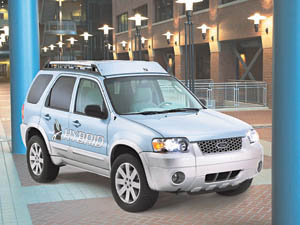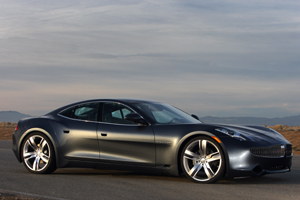Molicel President Lee Shares Views on Development of EV Battery Sector
Industry veteran says no fu
2010/09/24 | By Quincy LiangWith ominous events caused by drastic global climate changes, skyrocketing oil prices, as well as predictions of increasingly inaccessible crude that may become rare as diamonds in the next 20 years, transportation experts generally agree that EVs or electric vehicles is certainly the priority option to further develop, which makes practical if not exigent sense when transportation vehicles worldwide emit some 30% of greenhouse gases.
While global scientists, vehicle makers, and many governments of industrially advanced nations continue to urge stepping up EV technology development and usage, the hurdle in the way of building more practical and affordable EVs remains finding the right material to build lithium-ion cells that can power EVs with all the needed performance characteristics.
Raymond Lee, president of E-One Moli Energy Corp. (Molicel) of Taiwan, recently confirmed the above by saying: “Currently no material or formula exists to make lithium-ion cells for EVs that can fully meet consumer needs by delivering safety, cruise range, battery life, price and rapid recharge.”
Insights from an Expert
At a recent forum focusing on new automotive technologies and new-energy solutions, Lee said simply to hundreds of listeners from industry: “Consumers want EVs that are as easy to use as internal combustion engine (ICE) cars. In other words they want EVs powered by Li-ion cells to be safe, rechargeable as quickly as refilling ICE cars, have battery life of about 10 years, and once-per-five-days recharging frequency. Considering such perhaps currently unrealistic demands, major global EV power-cell makers are also building Li-ion cells that won't explode, can be recharged to 80% capacity within 15 minutes, cost less than US$250 per Kwh, will last 2,000 recharge/discharge cycles, and can cruise 150 miles per recharge.
Citing different sources, Lee said that the annual demand for lithium-ion batteries is expected to grow 20% yearly through 2017 with ample demand especially from the EV application market. In 2009, hybrid electric vehicle (HEV) and battery electric vehicle (BEV) generated only 0.03% of the global demand for lithium-ion cells, compared to 45.07% by cellphones, 29.02% by notebook PCs, 3.71% by portable audio players, and 4.42% by digital cameras etc. But by 2020, Lee said that shipments of EV lithium batteries would make up over 28% of the global supply, compared to 46% used in notebook PCs, 11% in cellphones, 10% in power tools etc.
Predictions and Trends
Predicting three major trends for the global EV power-cell market over the next few years, Lee said there is a risk of supply shortage due to surging demand, the trend to build bigger batteries for EVs, and 18650-type cylindrical power cells.
Summing up EVs and their battery demands, Lee said that HEVs require high power-density cells, with BEVs needing high energy-density cells. “With higher amperage or generally between 5A to 20A in DC cells, currently three types of anode materials are the most feasible for EVs, including LiFePO4, LiMn2O4, and nickel manganese cobalt (NMC), none of which can fully deliver performance to meet typical drivers' requirements.”
Influenced mainly by design parameters as cost, packaging efficiency and yield rate etc., Lee said that EV power cell sizes are getting increasingly larger; while practical demand related to planning to design for safety, performance and cost will inevitably integrate design of cells and battery pack modules.
Business Transformations


A new business model forming is to cluster battery and automotive industries as the EV sector hums ahead, Lee said. Initially, increasingly more battery-pack assembly will be part of the EV assembly lines, or such packs can be made by suppliers in or near EV factories. Furthermore and along a similar track, Lee said that distance will be shortened between demand and supply: cell production will be localized, with cells to be made by suppliers nearby or an automaker to minimize shipping distance of cells. Adopting such just-in-time strategy will help cut cost to make and supply batteries, as well as help speed the development of EV cell technologies.
Joint ventures between cell makers and automakers are another feasible business model that can help to customize batteries, and protect technical exchanges; achieve efficient management of performance and safety of battery production processes from cells to module packs; propose cost-reducing projects for both cells and modules; and assure stable battery supply to also ease inventory pressure.
Established in 1998, E-One Moli is a leading lithium-ion battery maker in Taiwan that has become a mid-sized international player by focusing on niche markets. The company is already the world's second-largest supplier of Li-ion batteries for power tools and relatively mature BEVs as the BMW Mini-E and the Tesla Roadseter.
New Plant
E-One Moli expects to complete a new plant in southern Taiwan, its second on the island, in the second or third quarter of 2010. The new facility will be equipped with two advanced battery production lines: each with a capacity of 120 18650-type cylindrical Lithium Manganese (Li-Mn) cells per minute, raising E-One Moli's total annual capacity to 12 million cells.
As a major Li-ion power cell supplier in Taiwan and a leading global supplier, E-One Moli has shown its confidence in the future of the Li-ion cell sector in Taiwan by building the new plant.
Lee said that in the short term E-One Moli will continue promoting its existing 18650- and 26700-type cylindrical power cells for the EV segment, gradually introduce more EV dedicated cells, and diversify into HEV and BEV battery pack production. E-One Moli currently produces mostly LiMn2O4 and NMC cells, as well as possessing core technology in LiFePO4 anode.
“We will move towards developing bigger cells and second-generation LiFePO4 products, as well as target products featuring low formula cost, 10-year battery life, and upgraded safety and stability for cells used in ambient temperatures between -40 and +85 Celsius,” Lee said, adding that the maker's goal is to lead the EV-battery segment.
Apparently a modest executive, Lee said that working closely with major international EV makers has been educational for E-One Moli, including helping to greatly improve its EV battery module production and upgrading the yield rate through BMW's EV module design and module assembly. The benefit has been mutual, however, with E-One Moli helping BMW improve pack design and extend battery durability, Lee stressed.
Impressive Track-record
E-One Moli's track record is long in the EV segment, having supplied the Ford Escape hybrid SUV with a 3KWh battery pack with 240 IMR 26700A-type cells; Fisker Karma PHEV60 super PHEV sport car with a 22.6 Kwh pack with 2,200 IBR 26700A cells; and BMW Mini-E with a 35KWh pack with 5,000 18650 cells. E-One Moli is also versatile, supplying batteries for e-bicycles and e-scooters as the Sport XS700 pack; the Zero X pack; and the Zero S pack.
Revealing other business plans, Lee said that E-One Moli also aims to work with battery pack makers and vehicle producers to build battery exchange stations; battery maintenance and recycling; and power companies to develop intelligent power networks.
EV History
Retracing the history of EVs, Lee said that the first vehicle powered by an electric motor was built in 1828, with the burgeoning period of EVs being from 1830 to 1870; after which EVs underwent electrifying development between 1870 and 1920, with the first EV to top 100kmp being born in 1989. Between 1870 and 1920, gasoline-powered cars accounted for only 22% of the overall vehicle market, compared to 38% of EVs and 40% steam-driven cars.
After gasoline-powered cars sped ahead in development and growth between 1920 and 1980, Lee said, EVs have enjoyed a renaissance from the 1990s to now, driven mainly by the fear of the consequences of global warming, petroleum shortage etc. E-One Moli is poised to change history with unprecedented demand for Li-ion EV cells, Lee said, confirming such confidence by stating that E-One Moli intends to continue upgrading its corporate strength.
Caption 1: President of E-One Moli Raymond Lee: currently no suitable anode material exists to power EVs that deliver practical, gasoline-car-equivalent performance.
Caption 2: Molicel supplies Li-ion cells for many EVs as Ford Escape hybrid SUV, Fisker Karma super EV sport car, LUXGEN7 EV+ etc.
Caption 3: E-One Moli developed EV battery packs.




